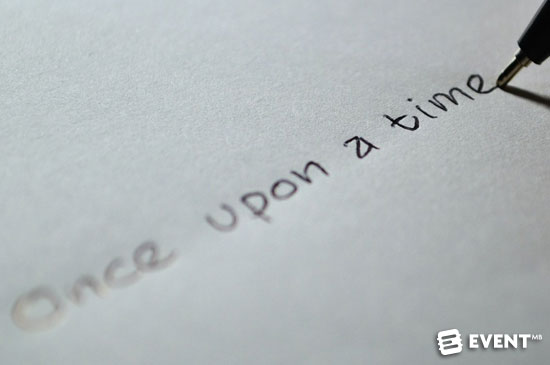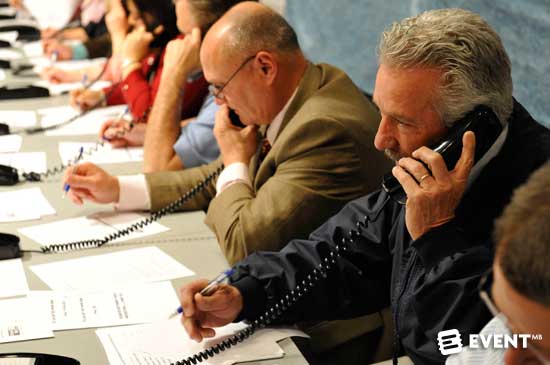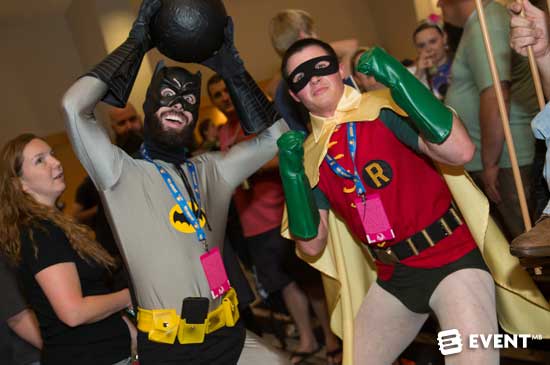Skift Take
“Tell me a story” is not just a bedtime-stalling tactic practiced by elementary school children everywhere. It’s a desire that runs as an undercurrent of many cultures. If you’re not using storytelling at your event, you’re missing an opportunity for connection and much more.
Okay, let’s be honest. There is no measurable way to prove the claim of mystical storytelling power when it comes to events but chances are that word made you click on this article. It sounds interesting, beguiling, alluring. It begs to be read and calls to you like distant land you can only access through an oversized piece of furniture.
Did you see what I just did?
I began painting a picture that probably ended with you thinking about a truly amazing story, the Lion, the Witch and the Wardrobe. Either that, or you never had a childhood.
But what exactly can storytelling do for your event? Quite simply it can:
- Transform an ordinary event into an extraordinary happening.
- Make attendees feel connected to the host organization.
- Help guests escape into a world of their choosing.
- Define your brand mission or culture.
- Inspire action.
Honestly, I could go on. Stories have been used for millions of years for everything from entertainment to trying to get out of trouble. They teach small children difficult concepts and they unite disjointed groups. But storytelling is only starting to make its way to events in a formal sense and here’s why that’sa really good thing:
What is Storytelling and Why Is It Important?
Storytelling in events is communicating something about you and what you identify (or disassociate) with. It allows people to feel in addition to think. It can be done visually, orally, or through written communication. The best event storytelling is woven throughout the entire event. A story should never live only on your about page or your opening presentation or message. It should resonate throughout.
Your story is the essence of your organization/event.
Storytelling is essential because it’s an easy way to:
- Entertain
- Inspire
- Educate
The broad phrase of storytelling encompasses a lot. At its most basic, it’s a literal story, a once upon a time moment. But in a more general sense, it can also be the lifeblood of your event. For instance, you can tell the story of how your event came to be. Your presenters can use story to educate. An attendee can share their story of why this event is so extraordinary, while you can also create an event that is a magical escape in an all-encompassing story like Dragoncon, which we’ll get to later. You can sell with story or increase loyalty and engagement.
But story can also be done simply by the language you use in your communications. People tend to skip over bland statements and cliches. Sprinkle your event communications with linguistic glitter. Make your pieces fun to absorb.
Brands have found storytelling to be so important in converting sales that enterprises like Nike keep a staff of brand storytellers on board. But storytelling is more than just a way to improve marketing. It triggers empathy and understanding.
According to Jeremy Hsu’s research, as published in Scientific American, it’s also the way we currently communicate. He found:
“Personal stories and gossip make up 65% of our conversations”
For those of us who love math, that’s over half. Half of our daily conversation is story-driven. No wonder people recognize and connect with it. Plus, have you even seen someone walk out of the room during a good story?
Why You Should Be Using Stories in Your Events
In addition to the possibilities mentioned earlier about what stories can do, stories are memorable. When we experience a story multiple areas of our brains respond. Leo Widrich wrote in the article, The Science of Storytelling: What Listening to a Story Does to Our Brains:
“When we listen to a standard presentation, our language processing regions in the brain, Broca’s area and Wernicke’s area are active. When we are being told a story though, not only are the language processing parts in our brain activated, but other areas in our brain, the ones we would use when experiencing the events of the story are stimulated as well.”
The brain doesn’t differentiate between experience and a good story so when you incorporate storytelling into your event you’re increasing the impression you make on your attendees and this activates referral and word of mouth marketing.
How Do You Tell Good Stories?
While there are many “goods” our cultures can agree on, when it comes to a good event story it must contain:
- At least one point your audience can identify with. Going into a third world country, for instance, and telling a story about a first-world dilemma like a crack in a cell phone screen won’t move many in that audience. You need something that will resonate with them. It can be something they’ve experienced or something they can imagine but it has to evoke a response. Remember, a story is a collaborative effort between you and the audience.
- Struggle. Without friction, it’s not a story. Tension is what keeps people involved. You need for them to wonder what’s next or what will happen. That “caring” is part of what makes the impression.
- A hero. This can be a single person or a group. The most effective stories will cast your attendees, or former attendees, as hero. You want your audience to see themselves in that role because you want them to cast you in the role of the person/organization that helped them achieve their success. They should be the hero. You can be the sage Gandalf or Obi Wan.
- A discernable ending or outcome. This isn’t an art school film. You need to provide your audience with an actual or foreseeable ending and it should be one that is bathed in optimism.
- A call to action. This is the difference between being an event planner and being a novelist. A writer needn’t worry about a call to action in a good story because the only call to action that matters is buying the book, or perhaps telling someone else about it. Preferably, Oprah. Anyone using storytelling for business had better be prepared to channel their audience’s emotional response into something. Don’t get them all worked up and inspired and let that opportunity pass.
A final point to good event storytelling, your story should not be a work of fiction. If it doesn’t align with your organization, it will not have the engaging, loyalty-building result you’re looking for.
5 Events That Are Successfully Using Storytelling
It’s difficult to be the first ones to embrace something new but you needn’t have those types of concerns over storytelling. There are already many groups using it with huge success, especially in the non-profit area. In the examples below, each event uses a different aspect of storytelling for event success:
The MDA Telethon: the Power of the Hero
One of the earliest blatant uses of storytelling at an event is the MDA telethon. Every year over the Labor Day weekend for 49 years, the telethon told the story of people struggling with Muscular Dystrophy. The stories were ones of triumph over struggle and the audience (millions of people) tuned in year after year. All the stories had a theme, they were looking for a cure.
While the stories were incredibly moving, the underlying story that was so effective in raising nearly $2 billion over its run was one that cast the viewer as the hero. Jerry Lewis, who hosted it for most of those 49 years, was careful to always point out that it was with the help of the viewers that they were going to find a cure. They couldn’t do it without their generous contributions. Who wouldn’t act on a chance to help and be the hero?
The Future of Storytelling: the Power of Engagement and Personalization
One would expect that a conference entitled the Future of Storytelling would use storytelling in an effective way. Its founder and head of Melcher Media, Charles Melcher, said, “The Future of Storytelling is an effort to bring a multidisciplinary group of people together to explore the ideas, the new forms, the technologies that are shaping communications in the 21st century,”
The two-day event that takes place on an 83-acre waterfront campus in Staten Island, New York provides attendees with videos prior to the conference. They are asked to rank their favorites. That information is then used to match attendees with sessions. After all, effective storytelling is also personalized.
This outside of conference homework strengthens the connection between artist/presenter and attendee so that the moment the attendee comes to the conference, there’s already meaningful conversation occurring. The hallway track isn’t the only excitement here. Sessions are places of exchange. Good storytelling is always communal.
Dragon Con: the Power of Imagination
Stories help us connect through empowering our imagination. They can help us escape our current existence or become something more. Some events use the power of story throughout. One of them is Dragon Con. According to its website, Dragon Con is the “largest multi-media popular culture convention focusing on science fiction and fantasy, gaming, comics, literature, art, music, and film in the universe.”
Dragon Con is held yearly in Atlanta and entices attendees to take part in cosplay as they enter a world very different from the one they live in. These attendees look forward to the ability to become someone else and the convention does its best to make that happen through signature events like its 2017 Jim Henson’s Labyrinth Masquerade Ball. The convention also includes Fan Tracks so attendees can select their favorite flights of fancy.
PetSmart: the Power of Connection
Have you ever looked at your pet and have been so moved by the way they looked at you or something they did that you had to stop and give them some attention. This is an emotion most pet owners connect on, regardless of whether you are a cat or dog person. It is almost a universal thing and PetSmart harnessed that power when they used the hashtag #inspiredbypets as part of its Inspiration Waggin’ event.
The multi-city truck tour brought the story of the importance of pets in our lives to people everywhere from retirement homes to college campuses. Their story united and spoke to people who all share an affinity for their pets. It created a heartwarming connection and pet lovers returned the sentiment by sharing their own stories online.
American Society of Radiologic Technologists: the Power of Transformation
Okay, so maybe this isn’t a story at a specific event but it does go a long way into telling member stories. The American Society of Radiologic Technologists opened a museum dedicated to telling its members stories. They wanted to tell the stories of the people who are behind all of the x-rays and imaging equipment and how that has changed throughout the years so they created a fixed exhibit of interactive learning to do so.
More on the Power of Storytelling at Events
- This article explains how you can use storytelling through 5 simple tactics. 5 Ways to Harness the Power of Storytelling at Events
- Want to see stories at work? Read Brand Storytelling at Events
- Let’s reverse it. How about great stories that became attractions? Read 6 Immersive Exhibitions that Became Attractions
In Conclusion
Storytelling should pervade every aspect of your event. It should begin with your organization, carry on through your venue, be embraced through your presenters, weave an amazing experience for your audience, and be felt as you say good-bye to one another. Because of this depth, it requires a clear and consistent message to everyone involved and representing your event.
Storytelling is not just a keynote with an amusing joke. Because of this, you want to take the time to craft your story the way a good novelist does. You want a consistent experience and message and a clear call to action at your event. After all, there’s no reason to take the time to develop and utilize the power of story if at the end all you do is turn off the lights.









